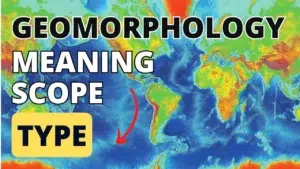Geomorphology is the scientific study of the physical features and processes that shape the Earth’s surface. It is an interdisciplinary field that draws on principles and methods from geology, geography, climatology, biology, and engineering.
Read Also: What is Physical Geography – Meaning, scope, and Type

Scope of Geomorphology
The scope of geomorphology includes the study of natural and human-induced processes that shape the Earth’s surface and the resulting landforms. It involves the investigation of landforms such as mountains, valleys, rivers, and coastlines, and the processes that form and shape them over time.
Geomorphology also encompasses the study of the impact of human activities on the natural landscape and the potential for natural hazards such as landslides, floods, and earthquakes. The field involves analyzing data from various sources, such as maps, satellite images, and field observations, to understand the complex processes that shape the Earth’s surface.
The knowledge gained from geomorphology has important applications in areas such as land use planning, environmental management, and natural disaster preparedness and response. Therefore, the scope of geomorphology is broad and interdisciplinary, drawing on principles and methods from geology, geography, climatology, biology, and engineering.
The primary goal of geomorphology is to understand how natural processes, such as erosion, weathering, and tectonic activity, create and modify the Earth’s landforms. This includes the study of landforms such as mountains, valleys, rivers, and coastlines, and the processes that form and shape them over time. Geomorphologists also investigate the impact of human activities, such as land use changes, deforestation, and urbanization, on the natural landscape and the potential for natural hazards such as landslides, floods, and earthquakes.
Read Also: Climatology – Introduction, meaning, and branches
Types of Geomorphology
There are several types of geomorphology, including:
- Structural geomorphology: This type of geomorphology studies the relationships between the Earth’s surface features and the underlying geology. It focuses on how geological structures such as faults and folds influence the formation of landforms.
- Process geomorphology: This type of geomorphology studies the natural processes that shape the Earth’s surface, including erosion, weathering, and tectonic activity. It seeks to understand the mechanisms that create and modify landforms.
- Climatic geomorphology: This type of geomorphology studies the impact of climate on the Earth’s surface features. It focuses on how climate variables such as temperature, precipitation, and wind shape the landscape.
- Human geomorphology: This type of geomorphology studies the impact of human activities on the natural landscape. It includes the study of land use changes, deforestation, and urbanization, and how these activities can alter the physical landscape and impact natural processes.
Read Also: What is Human geography – Meaning, Scope, and Type
Conclusion
In conclusion, geomorphology is a broad and interdisciplinary field that studies the physical features and processes that shape the Earth’s surface. It encompasses several types of geomorphology, including structural, process, climatic, and human, and has important applications in areas such as land use planning, environmental management, and natural disaster preparedness and response.
Read Also: Daily Newspaper